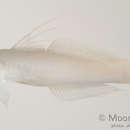Diagnostic Description
provided by Fishbase
Characterized by pale grey body color; yellowish head; bluish curved bar from below eye to opercle (Ref. 2798); thin bluish white bar on pectoral fin base; second to fourth dorsal spines prolonged as filaments in fish larger than about 4.5 cm; rounded caudal fin, longer than head; longitudinal scale series 101-126; ctenoid body scales, becoming cycloid anteriorly below first dorsal fin; head or midline of nape without scales; side of nape with scales extending forward to above or slightly before middle of opercle; fully scaled pectoral fin base and prepelvic area in adult; depth of body 4.5-5.1 in SL (Ref. 90102).
- Recorder
- Cristina V. Garilao
Diseases and Parasites
provided by Fishbase
Metacercaria Infection (Flatworms). Parasitic infestations (protozoa, worms, etc.)
Life Cycle
provided by Fishbase
Distinct pairing (Ref. 56363). Females spawn every 13 days while males guard the eggs which are laid in a burrow for 2-3 days (Ref. 56363). Both sexes impose monogamy as a practise by guarding each other against other possible mates (Ref. 56363). Mate guarding is made possible because all males were able to hold a nest site, both sexes exhibit strong site fidelity, and residents have an advantage in contests over mates (Ref. 56363). Monogamous mating is observed as both obligate and social (Ref. 52884).
Morphology
provided by Fishbase
Dorsal spines (total): 7; Dorsal soft rays (total): 17 - 19; Analspines: 1; Analsoft rays: 16 - 19
- Recorder
- Cristina V. Garilao
Trophic Strategy
provided by Fishbase
Common in clear outer lagoon and seaward reefs, over hard bottoms as well as over sand and rubble. Typical along reef-crests in depths of 1-6 m, but has also been collected from depths of 24 m. Usually seen in pairs, hovering near their burrow. Monogamous (Ref. 52884, 48637). Feeds on small benthic invertebrates, fishes, and fish eggs by sifting mouthfuls of sand.
- Recorder
- Drina Sta. Iglesia
Biology
provided by Fishbase
Common in clear outer lagoon and seaward reefs, over hard bottoms as well as over sand and rubble. Typical along reef-crests in depths of 1-6 m, but has also been collected from depths of 24 m. Usually seen in pairs, hovering near their burrow. Monogamous (Ref. 52884, 48637). Feeds on small benthic invertebrates, fishes, and fish eggs by sifting mouthfuls of sand.
- Recorder
- Estelita Emily Capuli
Importance
provided by Fishbase
aquarium: commercial
- Recorder
- Estelita Emily Capuli
Valenciennea strigata
provided by wikipedia EN
Valenciennea strigata is a species of fish in the family Gobiidae, the gobies. Its common names include the blueband goby, golden-head sleeper goby, and pennant glider.[1] It is native to the Indian Ocean and the western Pacific Ocean where it can be found in outer lagoons and the seaward side of reefs. It occurs in a variety of substrates, sand, rubble, hard, at depths of from 1 to 25 metres (3.3 to 82.0 ft) (usually at less than 6 metres (20 ft)). It primarily inhabits burrows dug under rubble, using them as both a nesting site and a refuge from predators. Such burrows typically have two entrances; however, only one of them is open, as the other is covered by rubble, sand, and algae.[2] It can also be found in the aquarium trade. This species can reach a length of 18 centimetres (7.1 in) TL. [3] It is the type species of the genus Valenciennea.[4]
References
-
^ Froese, R. and D. Pauly, Eds. Valenciennea strigata, Common Names. FishBase. 2017.
-
^ Reavis, Robert H. (July 27, 1995). "The natural history of a monogamous coral-reef fish, Valenciennea strigata (Gobiidae) .1. Abundance, growth, survival and predation". Environmental Biology of Fishes. 49 (2): 239–246. doi:10.1023/A:1007372725701. ISSN 0378-1909.
-
^ Froese, Rainer; Pauly, Daniel (eds.) (2013). "Valenciennea strigata" in FishBase. June 2013 version.
-
^ Eschmeyer, William N.; Fricke, Ron & van der Laan, Richard (eds.). "Valenciennea". Catalog of Fishes. California Academy of Sciences. Retrieved 16 September 2018.

- license
- cc-by-sa-3.0
- copyright
- Wikipedia authors and editors
Valenciennea strigata: Brief Summary
provided by wikipedia EN
Valenciennea strigata is a species of fish in the family Gobiidae, the gobies. Its common names include the blueband goby, golden-head sleeper goby, and pennant glider. It is native to the Indian Ocean and the western Pacific Ocean where it can be found in outer lagoons and the seaward side of reefs. It occurs in a variety of substrates, sand, rubble, hard, at depths of from 1 to 25 metres (3.3 to 82.0 ft) (usually at less than 6 metres (20 ft)). It primarily inhabits burrows dug under rubble, using them as both a nesting site and a refuge from predators. Such burrows typically have two entrances; however, only one of them is open, as the other is covered by rubble, sand, and algae. It can also be found in the aquarium trade. This species can reach a length of 18 centimetres (7.1 in) TL. It is the type species of the genus Valenciennea.
- license
- cc-by-sa-3.0
- copyright
- Wikipedia authors and editors
Description
provided by World Register of Marine Species
Common in clear outer lagoon and seaward reefs, over hard bottoms as well as over sand and rubble. Typical along reef-crests in depths of 1-6 m, but has also been collected from depths of 24 m. Usually seen in pairs, hovering near their burrow. Feeds on small benthic invertebrates, fishes, and fish eggs by sifting mouthfuls of sand.
Froese, R. & D. Pauly (Editors). (2023). FishBase. World Wide Web electronic publication. version (02/2023).
- license
- cc-by-4.0
- copyright
- WoRMS Editorial Board

